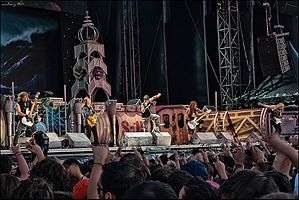List of Iron Maiden band members
| Iron Maiden | |
|---|---|
|
Iron Maiden live in Madrid, 16 July 2011. (l-r) Adrian Smith, Nicko McBrain (obscured), Dave Murray, Bruce Dickinson, Steve Harris, and Janick Gers. | |
| Background information | |
| Origin | Leyton, London, England |
| Genres | Heavy metal |
| Years active | 1975–present |
| Labels | EMI, Universal, Sanctuary, Epic, Columbia, Portrait, Capitol |
| Website |
ironmaiden |
| Members |
Steve Harris Dave Murray Adrian Smith Bruce Dickinson Nicko McBrain Janick Gers |
| Past members | Former members |
Iron Maiden are a British heavy metal band formed in 1975 by bassist Steve Harris. After several lineup changes prior to their recording career, they settled on Harris, vocalist Paul Di'Anno, guitarist Dave Murray and drummer Doug Sampson. The band released an EP as a four-piece, before hiring guitarist Dennis Stratton in 1979. Doug Sampson was dismissed from the band as he was unable to cope with the touring schedule and, at the suggestion of Stratton, replaced by Clive Burr, with whom the band recorded their self-titled debut album in 1980.[1] Later that year, Stratton was replaced by guitarist Adrian Smith, due to musical and personal differences brought about by choosing not to travel with the band when supporting Kiss on the European leg of their Unmasked Tour.[2]
During the tour supporting their second studio effort, Di'Anno was fired from the band after drug and alcohol abuse affected his live performance.[3] Vocalist Bruce Dickinson left his previous band, Samson, to audition for Iron Maiden in September 1981 and joined shortly afterwards. After the release of their third album, The Number of the Beast, drummer Nicko McBrain replaced Burr, who left due to personal and scheduling problems on the subsequent Beast on the Road tour.[4] This is considered by many as their quintessential lineup,[5] with which they released a series of high-impact works.[6]
In 1990, prior to the recording of their eighth studio album, Smith was asked to leave the band due to a lack of enthusiasm, brought about by the "stripped-down" musical direction they were taking, which Smith considered "a step backwards".[7] Janick Gers, an old friend of Dickinson's who performed on his debut solo album, became the new guitarist. This formation recorded one more album before Dickinson departed in 1993, in order to pursue his solo career further.[8]
The band listened to hundreds of tapes submitted by vocalists before asking Blaze Bayley to audition,[9] with whom they would go on to release two studio albums, after which Bayley left the band by mutual consent in January 1999.[10] At that point, the band were in talks with Dickinson,[10] who, after a meeting with Steve Harris and Rod Smallwood (the group's manager) in Brighton,[11] agreed to rejoin along with Adrian Smith, who was telephoned a few hours later.[12] Iron Maiden thus became a six-piece band and have gone on to make five further studio releases. The current lineup is now the longest and most stable in the band's history.
Current members
- Steve Harris
- Active: 1975–present
- Instruments: bass, backing vocals, studio keyboards (1988,1998–present)
- Release contributions: all Iron Maiden releases
- Harris founded the band in December 1975[13] and is the group's only constant member.[14]
- Dave Murray
- Active: 1976–1977, 1978–present
- Instruments: lead and rhythm guitars
- Release contributions: all Iron Maiden releases
- After Steve Harris expressed his dissatisfaction with the abilities of then guitarists Dave Sullivan and Terry Rance,[14] Murray auditioned for the band in late 1976 at the suggestion of then vocalist Dennis Wilcock.[15] Following Rance and Sullivan's departure in December 1976, Murray joined the band for six months until he was sacked following an argument with Wilcock.[16] Six months later, Wilcock left the band and Murray was immediately reinstated and has remained with the band ever since.[17]
- Adrian Smith
- Active: 1980–1990, 1999–present
- Instruments: lead and rhythm guitars, backing vocals, studio keyboards (1988)
- Release contributions: all Iron Maiden releases from Killers (1981) to Maiden England (1989), then from Brave New World (2000) to present
- The childhood friend of Dave Murray,[18] Smith was originally asked to join the band in 1979 when the band were on the verge of signing with EMI but turned them down to continue with his own band, Urchin.[19] A year later, Urchin split up and Smith joined Iron Maiden in November 1980.[20] Smith agreed to leave Iron Maiden in 1990 as he did not approve of the direction the band were aiming for on their next album, No Prayer for the Dying.[7] After a nine year absence, during which he formed his own band, Psycho Motel,[21] and joined Bruce Dickinson's solo outfit, Smith was asked to rejoin Iron Maiden in 1999.[12]
- Bruce Dickinson
- Active: 1981–1993, 1999–present
- Instruments: lead vocals, piano (2015)
- Release contributions: all Iron Maiden releases from The Number of the Beast (1982) to Raising Hell (1994), then from Brave New World (2000) to present
- Having admired the band from afar after first seeing them perform in 1980,[22] Dickinson agreed to leave his band Samson to audition for Iron Maiden in September 1981 and was immediately hired.[23] In 1993, after much deliberation, Dickinson decided to leave the band to focus on his solo career.[8] Following a gap of six years, during which he released four solo albums, the band's manager, Rod Smallwood, convinced Dickinson to rejoin the band in January 1999.[24]
- Nicko McBrain
- Active: 1982–present
- Instruments: drums, percussion
- Release contributions: all Iron Maiden releases from Piece of Mind (1983) to present
- McBrain became friends with Iron Maiden when his previous band, Trust, supported them in 1981.[25] When Clive Burr was sacked in late 1982, McBrain was immediately invited to join the group.[26]
- Janick Gers
- Active: 1990–present
- Instruments: lead and rhythm guitars
- Release contributions: all Iron Maiden releases from No Prayer for the Dying (1990) to present
- Upon Smith's departure from Iron Maiden in 1990, Gers, who was then a member of Dickinson's solo outfit, was asked to learn some of the band's songs for an audition held three days later, during which he was instantly hired.[27] When Smith returned to Iron Maiden in 1999, Harris insisted that Gers remained in the group, creating their current three-guitar lineup.[28]
-
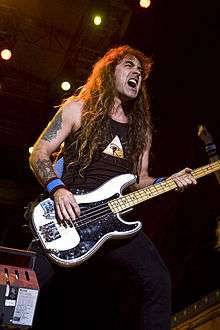
Steve Harris
Bass -
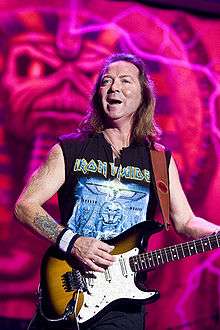
Dave Murray
Guitars -

Adrian Smith
Guitars -
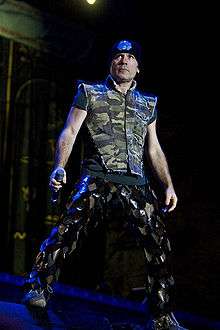
Bruce Dickinson
Lead vocals -
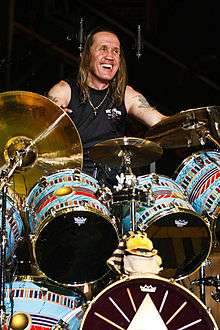
Nicko McBrain
Drums -

Janick Gers
Guitars
Iron Maiden performing at Estadio Ricardo Saprissa stadium, Costa Rica on 26 February 2008
Former members
- Paul Day
- Active: 1975–1976
- Instruments: vocals
- Release contributions: none
- Paul Day was the band's original lead vocalist, but was the first to leave the group because, according to Harris, "he didn't really have enough energy or charisma onstage."[15]
- Terry Rance
- Active: 1975–1976
- Instruments: guitars
- Release contributions: none
- As one of the band's original guitarists, Rance disagreed on Dave Murray's entrance in the band, taking it as a slight on his own ability.[29] To allow Murray to join, Steve Harris temporarily disbanded Iron Maiden in December 1976 and reformed the group soon afterwards without Rance or Dave Sullivan, the band's other original guitarist.[30]
- Dave Sullivan
- Active: 1975–1976
- Instruments: guitars
- Release contributions: none
- According to Sullivan himself, he "wasn't too bothered" with the prospect of Dave Murray joining the group, as he understood that "the lead sound was a bit lacking."[29] However, along with Rance, Sullivan was not invited to rejoin Iron Maiden when they temporarily disbanded in 1976.[30]
- Ron Matthews
- Active: 1975–1977
- Instruments: drums
- Release contributions: none
- The band's original drummer, Matthews states he was expelled from the band by their second vocalist, Dennis Wilcock.[31]
- Dennis Wilcock
- Active: 1976–1978
- Instruments: vocals
- Release contributions: none
- Wilcock replaced original vocalist Paul Day and was the first to introduce special effects to the band's stage show, including fake blood capsules (placed in his mouth as he'd run a sword across his lips) and face paint.[15] Wilcock convinced Harris to sack most of the band, including Murray following a row they had after a show at the Bridgehouse pub, Canning Town in 1977.[32] It was also claimed in The Early Days documentary that Wilcock disliked Murray's girlfriend.[31] Eventually, Wilcock decided he'd had enough with the group and left to form his own band, "V1".[17]
- Bob Sawyer (later Rob Angelo)
- Active: 1977
- Instruments: guitars
- Release contributions: none
- Bob Sawyer (who would later go by the name of "Rob Angelo")[31] would always try to upstage Murray, resulting in a confrontation with Harris (and expulsion from the group) after pretending to play guitar with his teeth when the audience could see that it was a trick.[33]
- Terry Wapram
- Active: 1977–1978
- Instruments: guitars
- Release contributions: none
- After Murray's dismissal from the group by Dennis Wilcock, Wapram was brought in as his replacement. Having only played in Iron Maiden as the sole guitarist, Wapram was sacked after expressing that he was not content with Dave Murray's reinstatement following Wilcock's departure.[31]
- Thunderstick (Barry Purkis)
- Active: 1977
- Instruments: drums
- Release contributions: none
- Thunderstick's stint in the band was left notoriously short, lasting just the one show at the Bridgehouse in 1977. According to Harris, he performed poorly throughout the gig, including a particularly bad solo, during which he shouted obscenities at the audience. Thunderstick would later claim that his bad performance was caused by a row with his wife.[34]
- Tony Moore
- Active: 1977
- Instruments: keyboards
- Release contributions: none
- With both Murray and Sawyer expelled from the band, Harris decided to try a keyboardist. After one show with Moore (the same played with Thunderstick on drums), Harris scrapped the idea.[34]
- Doug Sampson
- Active: 1977–1979
- Instruments: drums
- Release contributions: The Soundhouse Tapes (1979 demo), BBC Archives (four songs from 1979)
- Sampson first met Harris when they were both members of a band called Smiler in 1975.[35] When Harris formed Iron Maiden in December, Sampson was invited to join but refused, deciding to leave music altogether, although he resumed drumming a short while later.[36] In November 1977, Sampson attended the band's only show with Thunderstick and, after a conversation with Harris that evening, he agreed to join the group.[37] Sampson remained with the band until they signed with EMI in 1979, after which he was dismissed on 22 December as he could not cope with band's touring schedule.[38]
- Paul Di'Anno
- Active: 1978–1981
- Instruments: vocals
- Release contributions: all Iron Maiden releases from The Soundhouse Tapes (1979 demo) to Maiden Japan (1981 live)
- Following the departure of Dennis Wilcock, the band spent the summer and autumn of 1978 rehearsing while searching for a new vocalist. It was when the group were attending a heavy rock night at the Red Lion pub in Leytonstone that a friend of Harris' told them of Di'Anno and his ability as a singer.[39] A few weeks later, he auditioned for the band in November 1978 and was immediately hired.[40] After participating on Iron Maiden's first two studio albums, Di'Anno was fired from the group for his increasing unreliability brought on by his drug and alcohol usage.[41]
- Paul Cairns (AKA "Mad Mac")
- Active: 1978–1979
- Instruments: guitars
- Release contributions: The Soundhouse Tapes (1979 demo)
- Paul Cairns (also known as "Mad Mac") briefly joined Iron Maiden from winter 1978. According to Doug Sampson, Cairns did not fit in the band properly and left after three months.[42] Cairns himself states that the band dismissed him as they did not like his stage performance following a visit to hospital.[43] Although uncredited, Cairns appears on The Soundhouse Tapes demo.[43][44]
- Paul Todd
- Active: 1979
- Instruments: guitars
- Release contributions: none
- Paul Todd joined the band but never performed with them live as, according to Harris, "his girlfriend wouldn't let him".[42] Todd was only in the band for a week[31] in June 1979.[45]
- Tony Parsons
- Active: 1979
- Instruments: guitars
- Release contributions: BBC Archives (four songs from 1979)
- Tony Parsons joined in September 1979 and stayed in the band for just over two months as he was reportedly unable to match Murray's ability, but did perform with the band on the BBC's Friday Rock Show (later included on the BBC Archives album).[42] Parsons left just a few weeks before the band signed their contract with EMI in December 1979.[46]
- Dennis Stratton
- Active: 1979–1980
- Instruments: guitars and backing vocals
- Release contributions: Iron Maiden (1980), Live!! +one (1980 live)
- After Iron Maiden failed to hire Adrian Smith when they signed their deal with EMI in 1979,[47] Stratton was asked to audition for the band as Harris was aware of his abilities from seeing him perform regularly with a band named RDB.[48] It was during the recording of their debut studio album that Harris began noticing that Stratton's musical interests clashed with the rest of the band, culminating in an attempt to add extra vocal harmonies on the song "Phantom of the Opera", which Harris had removed.[49] He was eventually dismissed from Iron Maiden following a supporting tour with Kiss, during which Stratton spent little time with the rest of the group, often choosing to travel with the road crew instead.[50]
- Clive Burr
- Active: 1979–1982
- Instruments: drums
- Release contributions: all Iron Maiden releases from Iron Maiden (1980) to The Number of the Beast (1982)
- Burr replaced previous drummer Doug Sampson on 26 December 1979 at the suggestion of Dennis Stratton.[51] Burr was eventually fired from the band following their North American tour in 1982, during which his performance was affected by his offstage activities, culminating in one such incident when, according to Harris, Burr "spent most of the gig throwing up into a bucket at the side of his kit."[52]
- Blaze Bayley
- Active: 1994–1999
- Instruments: vocals
- Release contributions: The X Factor (1995), Best of the Beast (1996 - compilation, two new tracks), Virtual XI (1998)
- After hearing him perform with his previous band, Wolfsbane, who supported Iron Maiden on their 1990 UK tour, Harris convinced Bayley to audition for the band in 1994.[9] During his two world tours with Iron Maiden, Bayley suffered from vocal issues,[53] which Janick Gers has since stated was partly the band's fault for forcing him to sing out of his natural vocal register,[54] and was dismissed from the band in January 1999.[10] Although the group were, at that point, negotiating Bruce Dickinson's return to Iron Maiden, Harris maintains that Bayley would still have been asked to leave the band if Dickinson had not rejoined.[55]
-

Paul Di'Anno
-
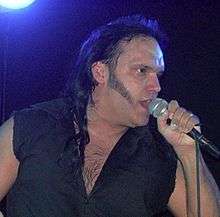
Blaze Bayley
-

Dennis Stratton
Touring musicians
- Michael Kenney
- Active: 1988–present
- Instruments: keyboards
- Release contributions: all Iron Maiden studio releases from No Prayer for the Dying (1990) to Virtual XI (1998), all live releases from Maiden England (1989) to present
- Since 1980, Michael Kenney has been employed by the band as Steve Harris' bass technician.[56] Following Iron Maiden's Seventh Son of a Seventh Son album, in which the band used keyboards for the first time, Harris insisted that Kenney perform the keyboard parts live under the alias of "The Count".[57] Following this tour, Kenney provided keyboards on their next four studio albums, after which Steve Harris took over playing keys with Kenney assisting.[58] He still provides the band's live keyboards, although, unlike the Seventh Tour of a Seventh Tour during which he performed on a forklift, Kenney now plays the keys backstage.[58] For the Maiden England World Tour 2012-13, Kenney reprised his role as "The Count" during performances of the song "Seventh Son of a Seventh Son".[59]
Timeline
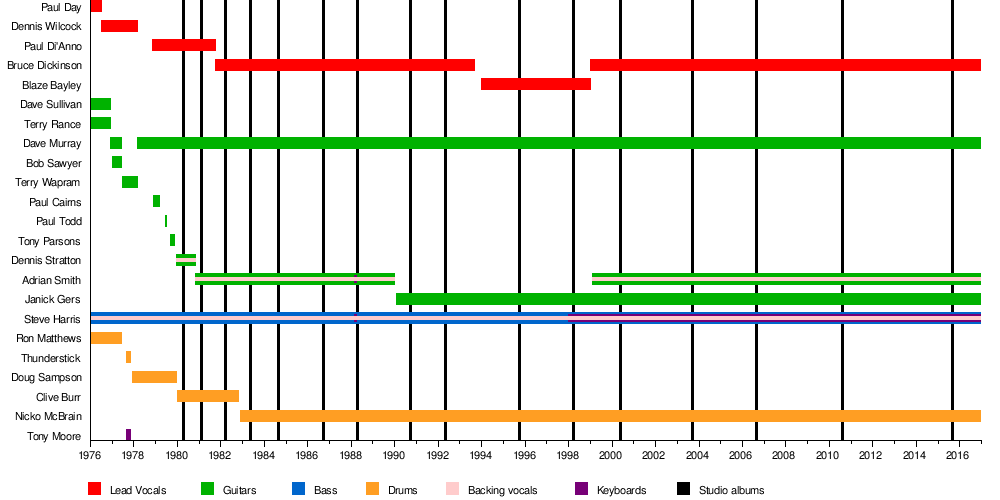
Recording timeline
| Role | Album | |||||||||||||||
|---|---|---|---|---|---|---|---|---|---|---|---|---|---|---|---|---|
| Iron Maiden (1980) |
Killers (1981) |
The Number of the Beast (1982) |
Piece of Mind (1983) |
Powerslave (1984) |
Somewhere in Time (1986) |
Seventh Son of a Seventh Son (1988) |
No Prayer for the Dying (1990) |
Fear of the Dark (1992) |
The X Factor (1995) |
Virtual XI (1998) |
Brave New World (2000) |
Dance of Death (2003) |
A Matter of Life and Death (2006) |
The Final Frontier (2010) |
The Book of Souls (2015) | |
| Lead vocals | Paul Di'Anno | Bruce Dickinson | Blaze Bayley | Bruce Dickinson | ||||||||||||
| Lead & Rhythm guitar | Dave Murray | |||||||||||||||
| Dennis Stratton | Adrian Smith | Janick Gers | ||||||||||||||
| N/A | Adrian Smith | |||||||||||||||
| Bass | Steve Harris | |||||||||||||||
| Drums | Clive Burr | Nicko McBrain | ||||||||||||||
| Keyboards | N/A | Steve Harris | N/A | Steve Harris | ||||||||||||
| Adrian Smith | Michael Kenney | N/A | Michael Kenney | |||||||||||||
Band lineups
| Years | Lineups | Releases |
|---|---|---|
|
— | |
|
— | |
|
— | |
|
— | |
|
— | |
|
| |
|
| |
|
| |
|
| |
|
| |
|
| |
|
| |
|
January 1999[11]– present |
|
|
- ↑ Mick Wall reports that, following Dennis Wilcock's departure, the band spent six months rehearsing as a three-piece whilst looking for a new lead vocalist.
- ↑ Demo EP
Notes
- ↑ Wall 2004, pp. 122–124.
- ↑ Wall 2004, pp. 160–163.
- ↑ Wall 2004, pp. 194–195.
- ↑ Wall 2004, pp. 232–234.
- ↑ Prato.
- ↑ MTV 2006.
- 1 2 Wall 2004, pp. 283–284.
- 1 2 Wall 2004, p. 293.
- 1 2 3 Wall 2004, p. 301.
- 1 2 3 Wall 2004, p. 324.
- 1 2 3 Wall 2004, p. 329.
- 1 2 Wall 2004, pp. 330–331.
- ↑ Bushell & Halfin 1985, p. 8.
- 1 2 Wall 2004, p. 14.
- 1 2 3 Wall 2004, p. 32.
- ↑ Bushell & Halfin 1985, p. 9.
- 1 2 3 Wall 2004, p. 50.
- ↑ Wall 2004, p. 165.
- ↑ Wall 2004, p. 169.
- 1 2 3 Wall 2004, p. 162.
- ↑ Wall 2004, p. 326.
- ↑ Wall 2004, p. 214.
- ↑ Wall 2004, p. 218.
- ↑ Wall 2004, p. 328.
- ↑ Wall 2004, p. 234.
- 1 2 Wall 2004, p. 235.
- 1 2 3 Wall 2004, p. 285.
- ↑ Wall 2004, p. 331.
- 1 2 3 Wall 2004, p. 33.
- 1 2 Wall 2004, p. 34.
- 1 2 3 4 5 EMI 2004.
- 1 2 3 Wall 2004, p. 46.
- ↑ Wall 2004, p. 44.
- 1 2 3 4 Wall 2004, p. 48.
- ↑ Wall 2004, p. 25.
- ↑ Wall 2004, p. 26.
- ↑ Wall 2004, p. 49.
- ↑ Wall 2004, pp. 122-123.
- 1 2 Wall 2004, p. 52.
- ↑ Wall 2004, pp. 53-54.
- ↑ Wall 2004, pp. 194-195.
- 1 2 3 Wall 2004, p. 64.
- 1 2 Dome 2014.
- ↑ Newhouse 2013.
- ↑ Bushell & Halfin 1985, p. 26.
- ↑ Wall 2004, p. 108.
- ↑ Wall 2004, p. 118.
- ↑ Wall 2004, pp. 120-121.
- ↑ Wall 2004, pp. 128-129.
- ↑ Wall 2004, pp. 160-163.
- ↑ Wall 2004, pp. 124-125.
- ↑ Wall 2004, pp. 232-233.
- ↑ Wall 2004, p. 321.
- ↑ Brave Words & Bloody Knuckles 2010.
- ↑ Wall 2004, p. 323.
- ↑ EMI 2006.
- ↑ Wall 2004, p. 266.
- 1 2 Gennet 2010.
- ↑ Grow 2012.
- ↑ Wall 2004, p. 27.
- ↑ Wall 2004, p. 43.
- 1 2 Wall 2004, p. 54.
- ↑ Wall 2004, p. 123.
- ↑ Wall 2004, p. 124.
- 1 2 Wall 2004, p. 216.
- ↑ Wall 2004, p. 241.
- ↑ Wall 2004, p. 298.
References
- "Janick Gers interview- Talking Metal Pirate Radio #5". Brave Words & Bloody Knuckles. 26 August 2010. Retrieved 25 February 2012.
- Bushell, Garry; Halfin, Ross (1985). Running Free, The Official Story of Iron Maiden (second ed.). Zomba Books. ISBN 0-946391-84-X.
- Dome, Malcolm (2014). "The Ex-Factor". Classic Rock presents Iron Maiden: From the East End to the World: 8–9.
- The History of Iron Maiden – Part 1: The Early Days (DVD). EMI. 23 November 2004.
- "Documentary". Death on the Road (DVD). EMI. 6 February 2006.
- Gennet, Robbie (3 October 2010). "Michael Kenney - the Man Behind the Maiden". Keyboard Magazine. Retrieved 19 April 2012.
- Grow, Kory (5 July 1012). "Live Review: Iron Maiden and Alice Cooper, Live in Newark, New Jersey". Revolver. Archived from the original on 11 July 2012. Retrieved 10 July 2012.
... an organist who looked like a medieval witch rose up and played with the band.
- "The Greatest Metal Bands of All Time". MTV. Viacom Media Networks. 14 July 2006. Retrieved 8 November 2008.
- Newhouse, Steve (4 February 2013). "Loopy's World: Part Five A - Recording Demos at Minus 20 Degrees Revisited". Metaltalk.net. Retrieved 19 March 2013.
- Prato, Greg. "Piece of Mind > Review". AllMusic. Rovi Corporation. Retrieved 3 November 2008.
- Wall, Mick (2004). Iron Maiden: Run to the Hills, the Authorised Biography (third ed.). Sanctuary Publishing. ISBN 1-86074-542-3
